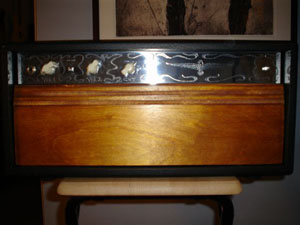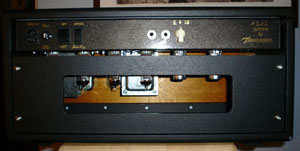
|
<< back to reviews Thunderbird Custom Amp review By Ola Gustavsson for UGG. Thunderbird Custom Amp  I have played and owned a few amplifiers over the years. There is something to be said for each and every one of them. Some of them have taught me how to play with dynamics. Others have been more about sheer power or trying to achieve the right distortion sound. Nowadays, I have learned to accept and take advantage of the fact that amps are different and most good amps have their own merits. In some cases, however, the difference is striking, and you know straight away that this is where you are heading next in your search for that elusive great guitar tone. If you ever have the opportunity to try out a Thunderbird Custom Amp, you'll know what I mean.
I have played and owned a few amplifiers over the years. There is something to be said for each and every one of them. Some of them have taught me how to play with dynamics. Others have been more about sheer power or trying to achieve the right distortion sound. Nowadays, I have learned to accept and take advantage of the fact that amps are different and most good amps have their own merits. In some cases, however, the difference is striking, and you know straight away that this is where you are heading next in your search for that elusive great guitar tone. If you ever have the opportunity to try out a Thunderbird Custom Amp, you'll know what I mean.
Before placing the order, I had long been a fan of EL84 tubes and "class A" amplifiers. Sorry to say, until receiving it, I hadn't actually owned one or tried them out thoroughly. Most of my amps have been based around EL34 power stages and I was curious about the Vox-like character that EL84s were supposed to produce. So, I decided on that. Another quality in sound that I wanted was touch sensitivity. I followed the recommendation of a friend and ordered a Thunderbird Amp and these are my impressions of it. The amp I ended up with was a single channel cathode bias EL84 loaded amp with just a volume and a hi-cut control. That's pretty much it as far as features go. There is no fx lopp, no master volume and no reverb, just a bare bones great amp. Turning it on, you'll notice that it is dead quiet. Standing really close, you can hear a slight hum from the transformers at work, but other than that, it is silent even with the volume knob turned up a bit. Adding some volume from your guitar, you immediately sense that this is a loud amp as the amount of gain reveals itself. 
At low volumes, there is a wide dynamic range. Adding just a little bit of attack with your fingers, produces loud notes instantly and they seem to jump out by themselves. Every nuance of your playing gets heard and comes straight through. This makes it quite hard to play at first and you have to get used to it, adapting attack to amplifier response. This is where phrasing skills are best heard and enjoyed. Turning up the volume slightly, you notice how a mild compression sets in, making subtle playing nuances shine through while still adding a slight natural compression to the loudest notes. This adds warmth and character to the sound. At louder settings, the amp virtually sings, and the distortion is warm and pleasant. By varying how hard you dig in with the pick, you can get everything from a jazzy tone with some mild grit to really strong, punchy singing notes, urging you to go into harmonic feedback. This is an amp that is meant to be controlled with your guitar volume. Using an attenuator and quite a lot of grit in the sound, I rolled off the guitar volume, and the sound cleaned up, not abruptly, but almost in a linear fashion. The drop in volume is there, but far less than you'd expect. Normally, this affects your tone so much that it's not really a realistic way of using the guitar, but with this amp, it seemed natural and the tone retains definition and projection well and simply gets progressively cleaner as you roll off. What I find most amazing with the amp is how it is balanced over frequencies. It has the right amount of brightness to be present without being harsh and just the amount of midrange to be full-bodied without drowning other instruments. Bass response is just where I want it. Overall, it has a warm tone that suits my telecasters well. The tone stands out in a mix, but doesn't impose restrictions on the other instruments and has a pocket of its own. Trying a Les Paul guitar, I expected the tone to be a little too thick. Changing guitars this way often makes me reach for the eq and reduce the bass response. Much to my surprise, this was not an issue with the Thunderbird amp. The warmth in tone seems to emanate from a carefully designed midrange response and not, as you'd expect, from the lowest frequencies. My concerns for too much bass were unfounded. It was still balanced and needed no tonal adjustment. For obvious reasons, the extra output of humbuckers allows for even more variation using the volume knob. You can easily go from a crunch sound to a searing lead sound simply by adjusting the volume. I have yet to try it in a band setting, but recording it was a breeze and it never needed any eq:ing at all except for maybe a little extra treble response. Moving the mic around and experimenting with placement, speakers and cabinets was very rewarding. I could go on and on about this, but it's an amp that merges with you and your guitar. It becomes an integral part of your instrument and learning to extract variety and nuances with it is part of the experience. It isn't for the faint hearted, as it is quite loud and it's not meant to have a lot of headroom either. But this is the way it's supposed to be, and rest assured, you won't be needing any pedals or reverb with it. Sound samples thunderbird 1 thunderbird 2 thunderbird 3 thunderbird 4 thunderbird 5 "All clips were recorded using a Marshall 1936 cabinet with Fane speakers, a Shure SM57 microphone and a Focusrite Trakmaster preamp connected to the soundcard. Guitars used were a Levinson Blade R4 with Bartolini pickups (clips 1, 3 and 5), a Bill Lawrence Swampkaster (clip 2) and a Les Paul Studio (clip 4). The only pedal used was a Morley wah on clip 4. Back track by Mats Nermark on clip 1 and 2" /ola UGG note: All Thunderbird amps are hand built in Sweden. More company information coming soon. Meanwhile send us an email if you want more information. << back to reviews |